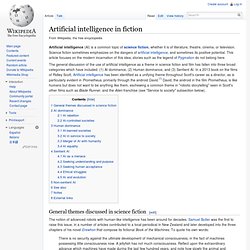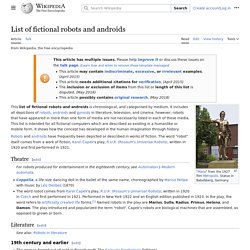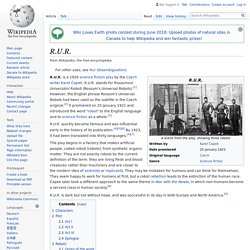

Collection Section 3 Commentary - AI in Culture. Artificial intelligence in fiction. The general discussion of the use of artificial intelligence as a theme in science fiction and film has fallen into three broad categories which have included: (1) AI dominance, (2) Human dominance, and (3) Sentient AI.

In a 2013 book on the films of Ridley Scott, Artificial intelligence has been identified as a unifying theme throughout Scott's career as a director, as is particularly evident in Prometheus, primarily through the android David.[1] David, the android in the film Prometheus, is like humans but does not want to be anything like them, eschewing a common theme in "robotic storytelling" seen in Scott's other films such as Blade Runner, and the Alien franchise (see "Service to society" subsection below). General themes discussed in science fiction[edit] There is no security against the ultimate development of mechanical consciousness, in the fact of machines possessing little consciousness now.
A jellyfish has not much consciousness. Robot Takeover: 100 Iconic Robots of Myth, Popular Culture & Real Life: Amazon.co.uk: Ana Matronic: 9781844038565: Books. List of fictional robots and androids - Wikipedia. This list of fictional robots and androids is chronological, and categorised by medium.

It includes all depictions of robots, androids and gynoids in literature, television, and cinema; however, robots that have appeared in more than one form of media are not necessarily listed in each of those media. This list is intended for all fictional computers which are described as existing in a humanlike or mobile form. It shows how the concept has developed in the human imagination through history. Static computers depicted in fiction are discussed in the separate list of fictional computers.
Theatre[edit] Literature[edit] Celia-killer-bots-attacking-thom mango concept-art 02 19th century and earlier[edit] Early 1900s[edit] 1920s[edit] 1930s[edit] 1940s[edit] 1950s and 1960s[edit] Metropolis (1927) Alien - Le 8ème passager (1979) Blade Runner (1982) Terminator (1984) Runaround by Isaac Asimov. 2001: A Space Odyssey (Space Odyssey, #1) by Arthur C. Clarke. The Hitchhiker's Guide to the Galaxy (Hitchhiker's Guide to the Galaxy, #1) by Douglas Adams.
Robopocalypse (Robopocalypse, #1) by Daniel H. Wilson. Star Trek: The Next Generation (TV Series 1987–1994) Battlestar Galactica (TV Series 2004–2009) Real Humans (100% Humain) (TV Series 2012– ) Westworld (TV Series 2016– ) R.U.R. - Wikipedia. R.U.R. quickly became famous and was influential early in the history of its publication.[4][5][6] By 1923, it had been translated into thirty languages.[4][7] R.U.R. is dark but not without hope, and was successful in its day in both Europe and North America.[9] Characters[edit] A scene from the play, showing the robots in rebellion Parentheses indicate differences in translations.

Humans[10] Harry Domin (Domain): General Manager, R.U.R.Fabry: Chief Engineer, R.U.R.Dr. Robots and robotesses Marius, a robotSulla, a robotessRadius, a robotPrimus, a robotHelena, a robotessDaemon (Damon), a robot Plot[edit] Act I[edit] Helena, the daughter of the president of a major industrial power, arrives at the island factory of Rossum's Universal Robots. In 1920, a man named Rossum came to the island to study marine biology, and in 1932 he accidentally discovered a chemical that behaved exactly like protoplasm, except that it did not mind being knocked around.
Helena meets Fabry, Dr. Act II[edit] Act III[edit]